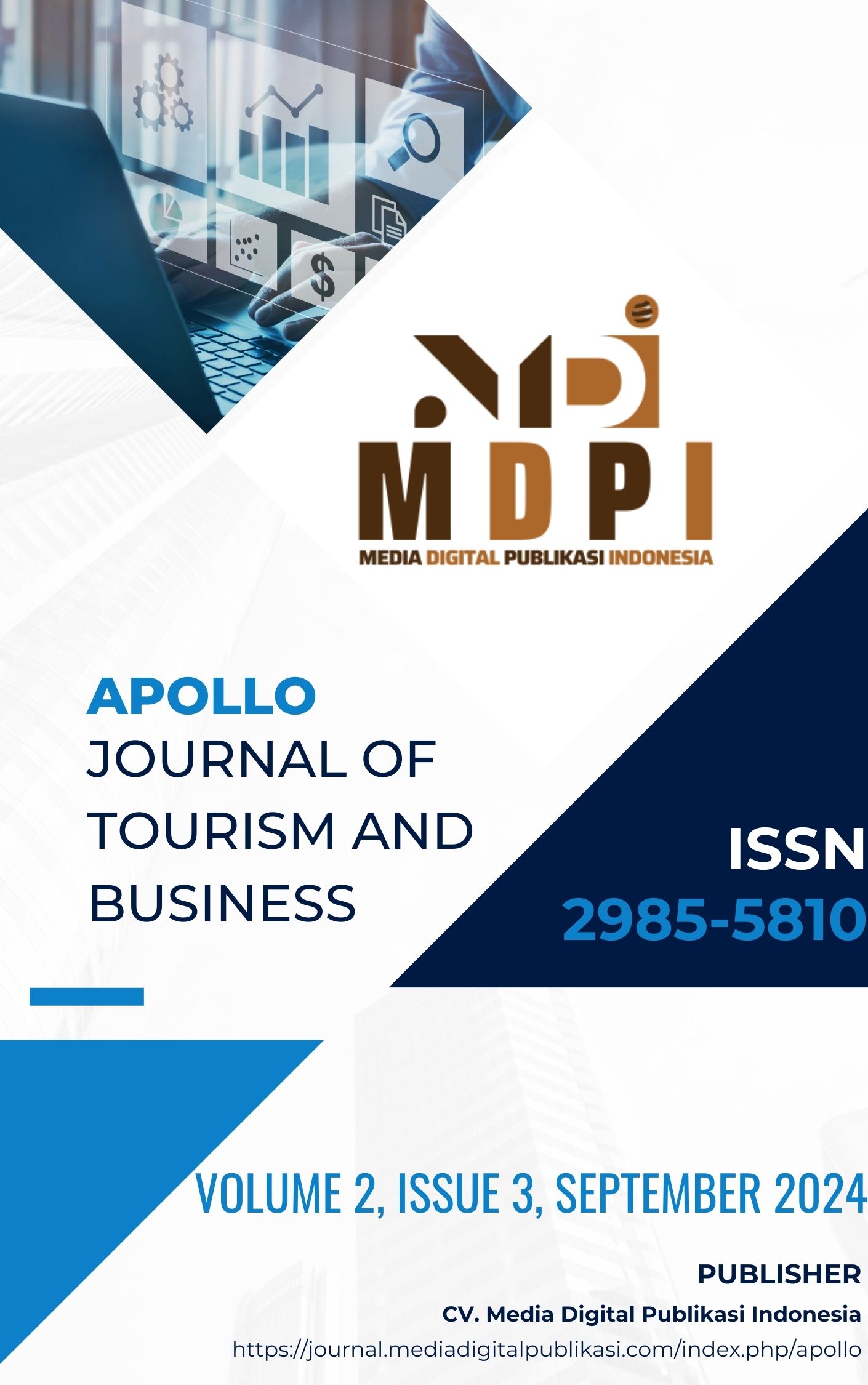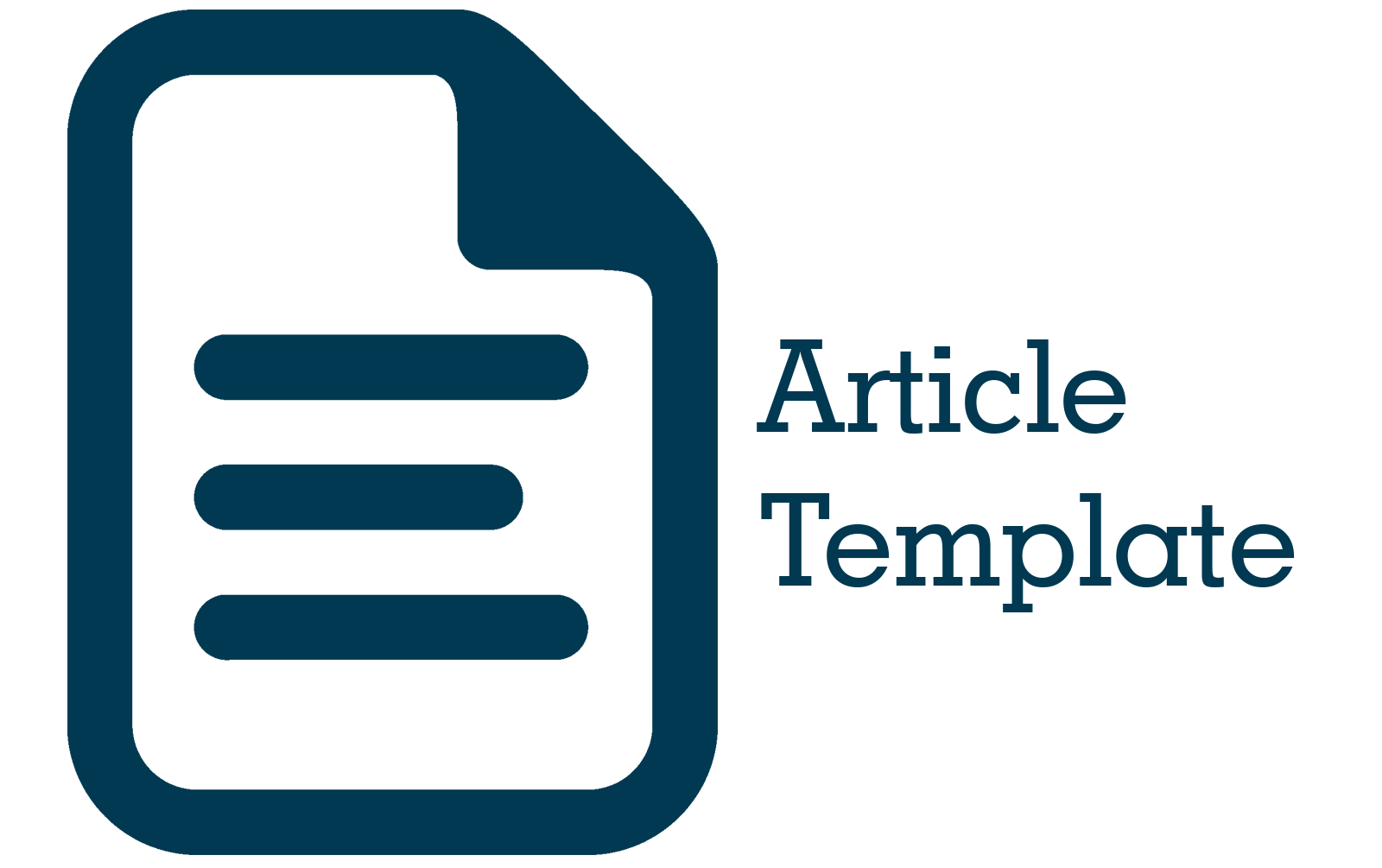Magnets Branding Become a Solution for Halal Tourism in Alamendah Tourism Village
DOI:
https://doi.org/10.58905/apollo.v2i3.374Keywords:
Brand Identity, Halal Tourism, Magnet BrandingAbstract
Brand Identity is important for halal tourism. Because with Brand Identity, the branding that is created will be more attached to the minds of tourists. Because with brand identity, the branding that is created will have distinctive characteristics and the branding that is created will be more detailed, not only limited to a logo. In this study, an analysis will be carried out using the magnet branding method consisting of 15 steps with the Stratified Random Sampling data collection method. This study is different from other studies that discuss branding for tourism in general, this study discusses branding for halal tourism in tourist villages. The result is that this magnet branding is indeed needed for halal tourism in Alamendah Tourism Village so that tourism in Alamendah Tourism Village has advantages compared to the surrounding tourist villages through its halal tourism. For the planning of halal tourism development, namely halal educational park and path for disabled.
References
A. Nabilah, E. Djuwendah, and J. Raya Jatinangor Sumedang Km, “Potensi dan Strategi Pengembangan Agroekowisata Desa Alamendah Sebagai Kawasan Wisata Berbasis Masyarakat Potential And Agro-ecotourism Development Strategy Alamendah Village As A Community-based Tourism Area.”
A. Fitri Alyani, S. Tinggi Ilmu Ekonomi Pariwisata YAPARI, K. Fajri, and A. Riyanti, “Manajemen dan Pariwisata Pengaruh Kualitas Pelayanan dan Atraksi Wisata Terhadap Kepuasan Pengunjung di Desa Wisata Alamendah (The Effect Of Service Quality and Tourist Attractions On Customer Satisfaction in The Alamendah Tourism Village)”.
Y. M. Arif, D. D. Putra, D. Wardani, S. M. S. Nugroho, and M. Hariadi, “Decentralized recommender system for ambient intelligence of tourism destinations serious game using known and unknown rating approach,” Heliyon, vol. 9, no. 3, p. e14267, 2023, doi: 10.1016/j.heliyon.2023.e14267.
S. Al Qita, S. Lafifa Sunarya, and A. S. Rusydiana, “Ar Rehla: Journal of Islamic Tourism, Halal Food, Islamic Traveling, and Creative Economy Manajemen Pariwisata Halal (Sebuah Review Menggunakan Analisis Bibliometrik),” |, vol. 140, no. 2, pp. 2776–7434, 2022, doi: 10.21274.
N. Mayang wangi, “Ulasan 15 Langkah Magnet Branding,” Subiakto.com. [Online]. Available: https://subiakto.com/ulasan-15-langkah-magnet-branding/
C. Marvelyn, “Pengaruh Brand Identity Terhadap Brand Loyalty Melalui Brand Image dan Brand Trust,” J. Adm. Bisnis, vol. 3, no. 4, pp. 923–937, 2020.
G. Tovmasyan, “Raising The Effectiveness Of Tourism Marketing And Branding: Evidence From Armenia,” vol. 6718, no. 1, pp. 167–181, 2020.
K. Mogensen, “Branding a small state as an innovation business partner,” Place Brand. Public Dipl., no. 0123456789, 2024, doi: 10.1057/s41254-024-00335-8.
F. Feriyadin, A. Saufi, and B. H. Rinuastuti, “Pengembangan Pariwisata Halal Desa Setanggor,” Jmm Unram - Master Manag. J., vol. 10, no. 1A, pp. 1–12, 2021, doi: 10.29303/jmm.v10i1a.628.
L. Suharti, H. Sirine, and S. Martono, “Developing a Sustainable Tourism Village Model: an Exploratory Study,” J. Manaj. dan Kewirausahaan, vol. 25, no. 1, pp. 63–82, 2023, doi: 10.9744/jmk.25.1.63-82.
I. Firdausi, S. Marantika, Z. N. Firdaus, and R. Sajidah, “Lombok: Halal Tourism as a New Indonesia Tourism Strategy,” 2017, doi: 10.15242/heaig.h0317447.
X. Dong, H. Yuan, and L. Huang, “The Negative Effect of Team Performance on Sponsorship Brand Performance: The Mediating Role of Social Identity Threat,” Procedia Comput. Sci., vol. 221, pp. 17–24, 2023, doi: 10.1016/j.procs.2023.07.003.
P. H. Andersen, S. Åberg, and A. Bujac, “Corporate sustainable brand identity work and network embeddedness: Learnings from Better Place (2007–2013),” Ind. Mark. Manag., vol. 115, pp. 526–538, Nov. 2023, doi: 10.1016/j.indmarman.2023.10.014.
S. Ainin, A. Feizollah, N. B. Anuar, and N. A. Abdullah, “Sentiment analyses of multilingual tweets on halal tourism,” Tour. Manag. Perspect., vol. 34, Apr. 2020, doi: 10.1016/j.tmp.2020.100658.
A. Jaelani, “International Review of Management and Marketing Halal Tourism Industry in Indonesia: Potential and Prospects,” Int. Rev. Manag. Mark., vol. 7, no. 3, pp. 25–34, 2017, [Online]. Available: http:www.econjournals.com
G. Szondi, “Public Diplomacy and Nation Branding: Conceptual Similarities and Differences,” J. Public Relations, vol. 3, no. 1, pp. 40–51, 2024, doi: 10.47941/jpr.1774.
H. A. Hasan, “Pariwisata Halal: Tantangan Dan Peluang Di Era New Normal,” J. Pilar J. Kaji. Islam Kontemporer, vol. 13, no. 1, pp. 55–56, 2022, [Online]. Available: https://journal.unismuh.ac.id/index.php/pilar/article/download/7946/4823
J. Junaidi, “Halal-friendly tourism and factors influencing halal tourism,” Manag. Sci. Lett., vol. 10, no. 8, pp. 1755–1762, 2020, doi: 10.5267/j.msl.2020.1.004.
S. Wahyu Elda et al., “Strategi Branding Pariwisata Berkelanjutan GeositeTabiang Takuruang Di Sumatera Barat,” Ikraith Hum., vol. 8, no. 1, pp. 409–424, 2024, [Online]. Available: https://doi.org/10.37817/ikraith-humaniora.v8i1
D. Yulianti, Okta Vianti, Dian Kagungan, “Strategi Media Branding Pengembangan Sektor Pariwisata Kabupaten Pesisir Barat Sebagai Destinasi Wisata Internasional,” vol. 4, no. 2, pp. 55–64, 2023.
M. Almeyda-Ibáñez and B. George, “The evolution of destination branding: A review of branding literature in tourism,” J. Tour. Herit. Serv. Mark., vol. 3, no. 1, pp. 9–17, 2020.
M. Potapovs, “Place branding: is it public policy, or isn’t it?,” Place Brand. Public Dipl., vol. 20, no. 3, pp. 275–292, 2024, doi: 10.1057/s41254-024-00327-8.
J. Kandampully and D. Solnet, “Competitive advantage through service in hospitality and tourism: a perspective article,” Tour. Rev., vol. 75, no. 1, pp. 247–251, 2020, doi: 10.1108/TR-05-2019-0175.
R. Iliyasu and I. Etikan, “Comparison of quota sampling and stratified random sampling,” Biometrics Biostat. Int. J., vol. 10, no. 1, pp. 24–27, 2021, doi: 10.15406/bbij.2021.10.00326.
V. Clarke and V. Braun, “Thematic analysis,” J. Posit. Psychol., vol. 12, no. 3, pp. 297–298, 2017, doi: 10.1080/17439760.2016.1262613.
Zulkifli, N. Safrida, L. R. Sari, and M. A. , Dr. Vellayati Hajad, “The Light Of Aceh: Upaya Penguatan Destination Branding Berbasis Halal Tourism Sebagai Perwujudan Sustainable Development Goals 2030,” vol. 71, no. 1, pp. 63–71, 2021.
A. Sulaiman, T. Zulyadi, and Fitrianti, “ Strategi Branding Produk Lokal Wisata Halal Di Aceh,” J. Manaj. Dan Adm. Islam, vol. 3, no. 1, pp. 95–114, 2019, [Online]. Available: https://jurnal.ar-raniry.ac.id/index.php/alidarah/article/view/4985/pdf
R. S. Saptaningtyas, Z. Gazalba, T. Handayani, I. W. Sugiartha, and P. J. Putra, “Desain Pengembangan Desa Wisata Setanggor Berbasis Arsitektur Tradisional,” Vitr. J. Arsitektur, Bangunan dan Lingkung., vol. 11, no. 2, p. 141, 2022, doi: 10.22441/vitruvian.2022.v11i2.005.
M. Konecnik Ruzzier and L. de Chernatony, “Developing and applying a place brand identity model: The case of Slovenia,” J. Bus. Res., vol. 66, no. 1, pp. 45–52, Jan. 2013, doi: 10.1016/j.jbusres.2012.05.023.
M. Gul, J. Akbar, M. Ikramullah, and A. Raza, “International Halal Industry And Its Impact On Global Halal Market (A Historical Review And Future Business Prospect),” J. Posit. Sch. Psychol., vol. 6, no. 7, pp. 5890–5907, 2022, [Online]. Available: http://journalppw.com
A. R. Subarkah, Junita Budi Rachman, and Akim, “Destination Branding Indonesia Sebagai Destinasi Wisata Halal,” J. Kepariwisataan Destin. Hosp. dan Perjalanan, vol. 4, no. 2, pp. 84–97, 2020, doi: 10.34013/jk.v4i2.53.
M. J. Kim and J. H. Lim, “A comprehensive review on logo literature: research topics, findings, and future directions,” J. Mark. Manag., vol. 35, no. 13–14, pp. 1291–1365, 2019, doi: 10.1080/0267257X.2019.1604563.
J. Bettels and K. P. Wiedmann, “Brand logo symmetry and product design: The spillover effects on consumer inferences,” J. Bus. Res., vol. 97, no. December 2018, pp. 1–9, 2019, doi: 10.1016/j.jbusres.2018.12.039.
D. S. Pik, “Tourism Destination Branding Complexity,” J. Prod. Brand Manag., vol. 14, no. 4, pp. 258–259, 2005.
A. Karim, “Pengaruh Tagline Iklan Versi ‘Axis Hits Bonus’ Dan Brand Ambassador Terhadap Brand Awareness Kartu Axis (Studi Pada Mahasiswa STIE Amkop Makassar),” Movere J., vol. 1, no. 1, pp. 1–13, 2019, doi: 10.53654/mv.v1i1.28.
W. Achmad, N. Nurwati, and R. S. Sofro Sidiq, “Community Economic Empowerment Through the Development of Micro and Small and Medium Enterprises: a Case Study in Alamendah Tourism Village,” J. Econ. Empower. Strateg., vol. 06, no. Vol 6 No 2, pp. 99–104, 2023, doi: 10.23969/jees.v6i2.9377.
W. B. Tarunajaya, Sukmadi, H. Darmawan, A. D. Goeltom, and V. Simatupang, “Analisis Kualitas Daya Tarik Wisata Desa Alamendah,” Open J. Syst., vol. 18, no. 2, pp. 259–266, 2023, [Online]. Available: https://binapatria.id/index.php/MBI
Ade Dela Pratiwi, “Analisis Pasar Wisata Syariah di Kota Yogyakarta,” vol. 14, pp. 345–364, 2016.
P. Scorrano, M. Fait, A. Maizza, and D. Vrontis, “Online branding strategy for wine tourism competitiveness,” Int. J. Wine Bus. Res., vol. 31, no. 2, pp. 130–150, 2019, doi: 10.1108/IJWBR-06-2017-0043.
G. M. Notiasari, F. Nabilah, R. Didiet, R. Hidayat3, P. P. Sitorus, and S. Gultom, “The Promotion Strategy To Increase Public Awareness of Halal Logistics In Indonesia.”
M. R. Mahaputra and F. Saputra, “Relationship Word of Mouth , Advertising and Product Quality To Brand Awareness,” Dinasti Int. J. Digit. Bus. Manag., vol. 2, no. 6, pp. 1099–1108, 2021.
M. Rusli, R. Firmansyah, and Y. P. MBULU, “Halal Tourism Destination Development Model,” J. Environ. Manag. Tour., vol. 9, no. 6, p. 1296, 2019, doi: 10.14505//jemt.9.6(30).19.
A. Hossain Bhuiyan and A. Darda, “Prospects and potentials of halal tourism development in Bangladesh,” J. Tour., vol. 4, no. 2, pp. 93–106, 2018, doi: 10.26650/jot.2018.4.2.0007.
Husni Pasarela, Andri Soemitra, and Zuhrinal M Nawawi, “Halal Tourism Development Strategy in Indonesia,” Konfrontasi J. Kult. Ekon. dan Perubahan Sos., vol. 9, no. 1, pp. 14–26, 2022, doi: 10.33258/konfrontasi2.v9i1.188.
J. Cave and D. Dredge, “Regenerative tourism needs diverse economic practices,” Tour. Geogr., vol. 22, no. 3, pp. 503–513, 2020, doi: 10.1080/14616688.2020.1768434.
Ruslaini, “Establishing Sustainable Practices on Micro, Small and Medium Enterprises (MSMEs) to Advance Indonesia’s Economic Growth,” Grou, vol. 23529, no. 2, pp. 1–45, 2018.
M. Aria, L. D’Aniello, V. Della Corte, and F. Pagliara, “Balancing tourism and conservation: analysing the sustainability of tourism in the city of Naples through citizen perspectives,” Qual. Quant., no. 0123456789, 2023, doi: 10.1007/s11135-023-01774-w.
R. Grau-Gumbau, S. Agut-Nieto, S. Llorens-Gumbau, and I. M. Martínez-Martínez, “Managerial Training Needs: A Study of Spanish Tourism Organisations,” Tour. Hosp. Res., vol. 3, no. 3, pp. 234–244, 2002, doi: 10.1177/146735840200300304.
Downloads
Published
Issue
Section
License
Copyright (c) 2025 Nazira Maulida, Imam Indratno

This work is licensed under a Creative Commons Attribution-ShareAlike 4.0 International License.











